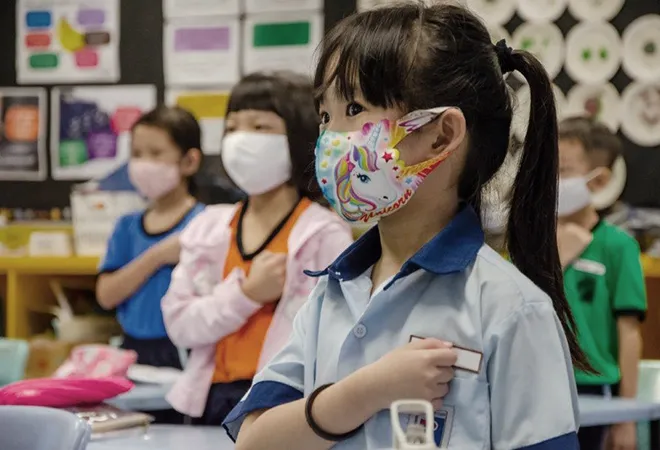
This article is part of the series Children and the Pandemic: An Analysis Across Countries
In an ideal year, students in Singapore attend school for 200 days. However, in 2020, Singapore’s primary and secondary school students physically attended 150 days (approx.) of school. The rest of the days of schooling were completed through home-based or blended-learning model. This article takes a look at the challenges faced by students during the COVID-19 pandemic and the policies adopted by the Singapore government to alleviate them.
Since the beginning of the pandemic, the Singapore government took an incremental and adaptive approach to school management. It implemented staggered breaks in school and suspended large whole school assemblies as early as 4 February 2020. This was followed by suspension of inter-school activities and reduction in tutorial class sizes. The government also imposed additional precautionary measures such as cleaning of school premises and limiting the number of visitors to create a safe physical learning environment. Such measures allowed Singapore to have two months of face-to-face classes for students.
In 2020, Singapore’s primary and secondary school students physically attended 150 days (approx.) of school. The rest of the days of schooling were completed through home-based or blended-learning model.
However, the rapid increase in daily cases, from just four in the beginning of March to about 74 at the beginning of April, blunted the effect of the precautionary measures. By the end of March, the government announced the start of a blended learning model—that involved one day of home-based learning a week—which was then converted into full home-based learning from 8 April to 4 May 2020.
This decision had varying effects on the learning and well-being of students. At school, all students have the same learning space (e.g., classroom), similar resources (e.g., computers, playgrounds, etc.) and similar learning time. These factors vary widely when students are unable to attend school. Students who live with their grandparents, younger children, or unemployed household members may have less space and time to devote to their studies at home, compared to students without such constraints. Similarly, students from families with higher income and wealth can afford better resources like electronic devices, a study table, separate rooms, and private tuition.
Apart from students, home-based learning also puts additional pressure on the parents and the family. A greater amount of time must be spent on supervising and caring for the children, which can mean a reduction in work hours. This could also lead to a reduction in care for other dependent members of the family, like the elderly. Some family members, especially women, might even be forced to leave their jobs, contributing to an increase in gender inequality.
The government also imposed additional precautionary measures such as cleaning of school premises and limiting the number of visitors to create a safe physical learning environment.
Measures undertaken
The Singapore government understood these challenges. For instance, it announced that the schools would provide access to electronic devices to students who could not purchase one. It also kept the government childcare centres open, especially for essential healthcare workers. However, alleviating space and time constraints is extremely difficult, if not impossible, for students who are of primary and secondary school going age. Schools provide an equitable environment, as described above, which is impossible to achieve in any kind of online-based learning arrangement.
Yet, the circumstances of the COVID-19 outbreak hindered the return of students to school, as cases in the community also started to affect school children. To tackle this problem, the government brought forward the school holidays from June to May 2020. This change in holiday schedule reduced the number of home-based learning days. When schools reopened in June 2020, the blended-learning mode was still in place, but as soon as the first wave of COVID-19 ended, the government switched to face-to-face classes.
This required safe management measures and staggered resumption of activities. These included scheduled cleaning and wiping of school premises, immediate testing on discovery of COVID-19 cases, strict adherence to mask and social distancing mandates and education of children regarding the pandemic. School activities were also resumed in a staggered manner; for instance, starting with low-risk activities and then moving to other high-risk co-curricular activities (e.g., playing wind instruments).
When schools reopened in June 2020, the blended-learning mode was still in place, but as soon as the first wave of COVID-19 ended, the government switched to face-to-face classes.
For the rest of the year, students enjoyed face-to-face classes. Singapore’s ability to provide such a high number of school days to students is a result of its high physical, human resource, and institutional capacity. Historically, Singapore’s placement of high value on school education has meant that the country has actively developed excellent school infrastructure (i.e., school buildings, playgrounds, etc.) and adequately trained its teachers and school administrators. Such infrastructure and highly skilled personnel were important to implement many of the measures listed above.
For instance, large and spacious school environments are essential for safe distancing. Availability of running water and clean toilets is essential for hand washing and general hygiene. At the same time, highly skilled personnel are important for conveying safe management measures to children and making sure that they follow them at school. Such measures also require the development of class activities that are easier to conduct safely.
Along with such factors, the agile policy response of the government also helped in avoiding loss of school days. The use of a blended-learning model and adjustment of holiday schedules were important steps in helping reduce the burden placed on parents and children. Rather than thinking in binaries of school closure and reopening, the government took a more nuanced approach to school management.
The agile policy response of the government also helped in avoiding loss of school days. The use of a blended-learning model and adjustment of holiday schedules were important steps in helping reduce the burden placed on parents and children.
Finally, at the institutional level, Singapore’s public ownership of schools allows the implementation of coordinated and standardised policy response (Table 1).
| Year-2019 |
Government |
Government-aided |
Independent |
| Primary |
138 |
41 |
0 |
| Secondary |
101 |
28 |
2 |
Source: Ministry of Education, Singapore
Government dominance in education enables it to steer the system in the needed direction for the benefit of society. If private schools occupied the major share of Singapore’s education sector, then it would have been a mammoth task for the government to coordinate a unified policy response to the pandemic.
Overall, Singapore has successfully provided a high number of school days to its students. While there is limited research in Singapore on the impact of this short-term school closure, studies conducted globally show mixed results in terms of the impact of school closure on pandemic containment and negative results on the health, well-being, and learning of students. Needless to say, these outcomes are mediated by the contextual factors, such as availability of internet, digital literacy, other non-school based nutrition programmes for children and housing condition.
Singapore continued to provide cash-based meal subsidies to parents irrespective of their children’s school attendance during the circuit breaker.
For Singapore, such contextual factors were supportive. The country has high internet penetration and digital literacy. At the same time, the housing policy of Singapore has ensured that more than 90 percent of the residents own their houses, which are built by the Housing Development Board (HDB), Singapore’s public housing champion. Finally, Singapore continued to provide cash-based meal subsidies to parents irrespective of their children’s school attendance during the circuit breaker. In 2021, the government has moved towards vaccinating students who are eligible, institutionalising its safe management measures and giving a more targeted response to outbreaks (e.g., shifting individual schools to home-based learning for shorter time periods).
Lessons and learnings
We have three learnings from Singapore. Firstly, school closure decisions must be made keeping in mind the magnitude of the benefits it provides. While there were doubts initially, but as time passed, evidence was clear that school closures had a marginal impact on controlling transmission. Secondly, the cost of school closures is high, especially in countries where non-school-based meal programmes and learning infrastructure are not in place, and therefore, operating schools with proper safety measures might be more suitable. Finally, if, and when, countries decide to close schools, they must avoid binary thinking (closure versus opening) and adopt a more nuanced approach towards managing schools.
The views expressed above belong to the author(s). ORF research and analyses now available on Telegram! Click here to access our curated content — blogs, longforms and interviews.




 PREV
PREV


